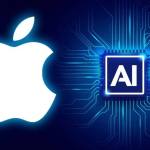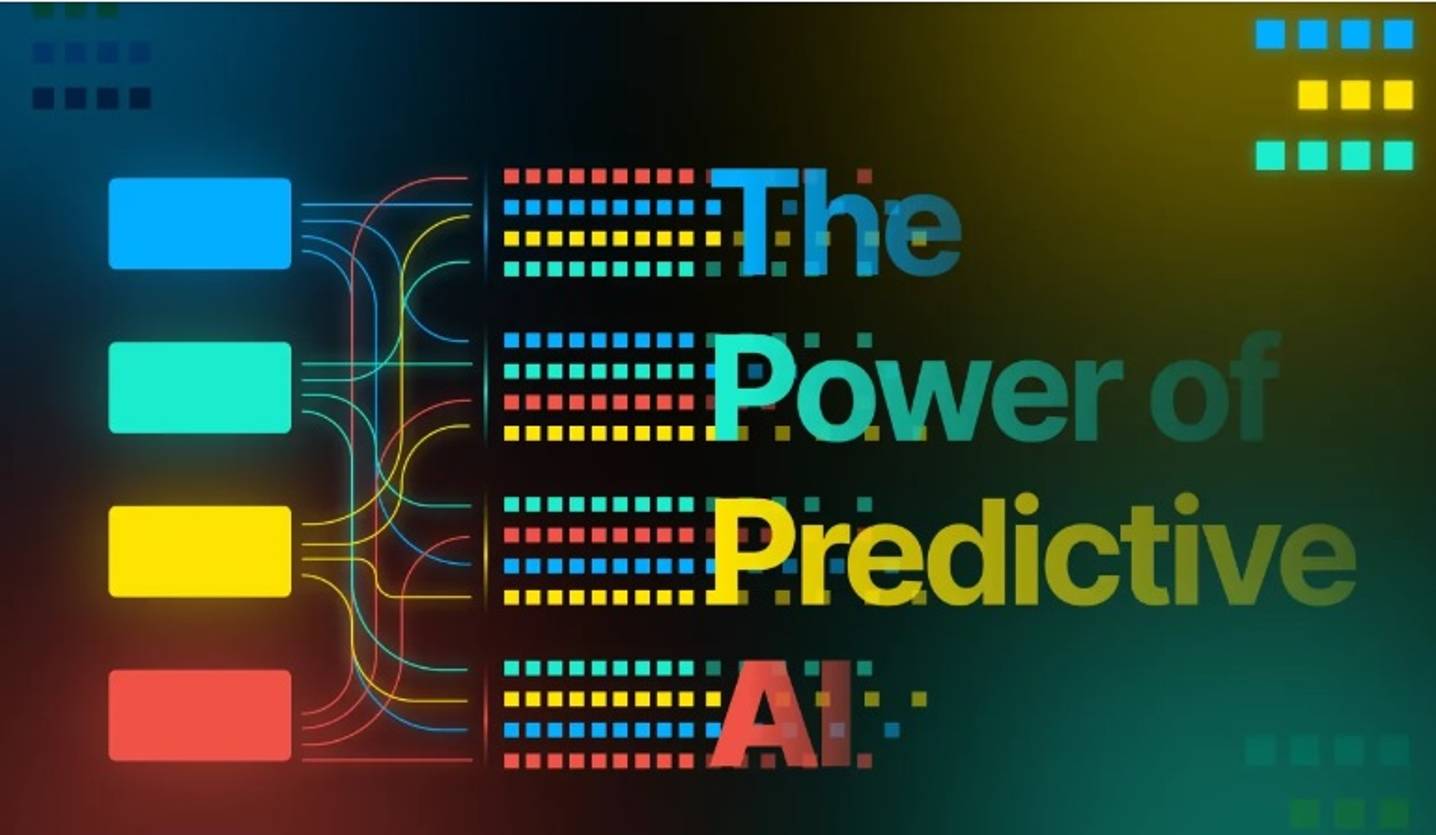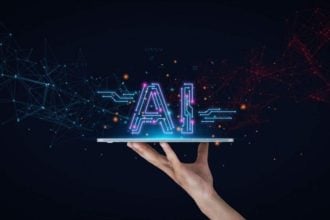In today’s rapidly evolving digital landscape, businesses are faced with the challenge of staying ahead in an increasingly competitive market. Predictive artificial intelligence (AI) significantly impacts our daily lives. Industries like healthcare, banking and finance, automotive, manufacturing, and retail have been utilising AI for more efficient operations.
Enter predictive AI, a groundbreaking technology that is reshaping the way companies operate, make decisions, and connect with customers.
More than just a buzzword, predictive AI is proving to be a game-changer across various sectors, from cybersecurity to retail innovation and healthcare advancements.
The AI market is poised for significant growth, projected to surge at an impressive 37.3% compound annual growth rate (CAGR) between 2023 and 2030, ultimately reaching an estimated value of $1,811.8 billion.
Predictive AI stands out as a pivotal driver of this expansion. In the realm of commerce, maintaining a competitive edge is paramount, and Predictive AI emerges as a solution, providing organisations with the ability to anticipate future trends.
Leveraging Predictive AI, businesses are empowered to make informed decisions, mitigate risks, and explore avenues for sustainable growth.
How Does Predictive AI Work?
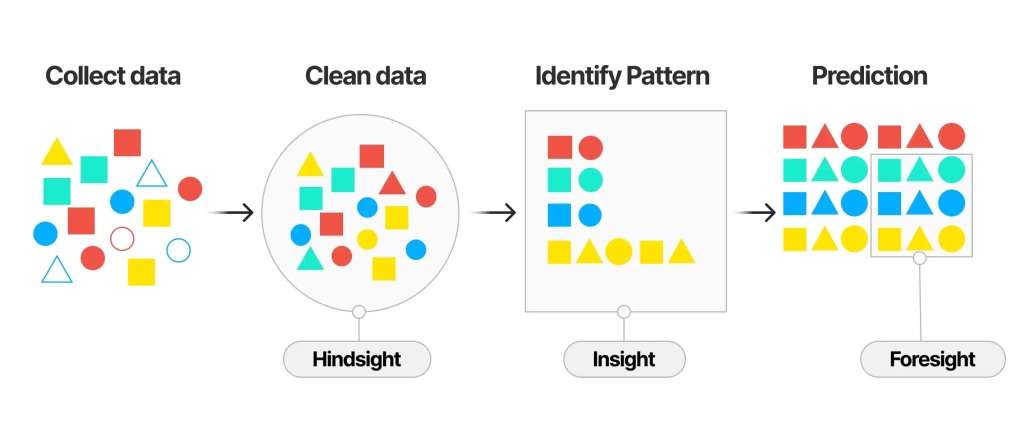
You know how Predictive AI works by diving into past data using fancy algorithms to figure out what might happen next, right? Well, let me break it down for you in simpler terms:
- Understanding Data and Finding Patterns So, imagine Predictive AI like a detective analyzing clues from the past. It looks at loads of historical data using special algorithms (think of them like smart detectives too) like linear regression, decision trees, and neural networks. These algorithms are like those super smart friends who can spot patterns in things.
- Learning from What’s Happened Before Next, Predictive AI starts learning from all this data. It’s like going to school for the AI. During this “schooling,” it looks at all the past data and tries to get better at guessing what might happen next. Just like how you get better at math by practicing problems, the AI gets better at predicting by looking at lots and lots of examples.
- Making Guesses about the Future Once the AI has learned enough, it starts making predictions about what might happen in the future. It’s a bit like predicting the weather, but instead of clouds and rain, it’s predicting things like how much a company might sell next quarter. And just like the weather forecast, these predictions aren’t always 100% accurate. Sometimes it might say there’s an 80% chance of something happening.
- Getting Smarter Over Time But here’s the cool part: Predictive AI doesn’t stop learning. It’s like a student who keeps studying and getting better grades. Whenever it gets new information, it uses that to improve its guesses for the future. So, it’s always trying to be more accurate, just like how you try to get better at your favorite video game.
- Putting it into Action Finally, Predictive AI isn’t just sitting around doing math problems. It’s actually helping businesses make important decisions. It’s like having a super smart advisor whispering in your ear, telling you what move to make next in a game. Businesses use these predictions to figure out things like how much stock to buy or where to focus their advertising.
So, think of Predictive AI like a really smart friend who’s always trying to figure out what’s going to happen next and helping businesses make better choices. It’s not magic, it’s just a clever way of using data to see into the future a bit.
- The World Of Statistics
In the world of statistics, increased data typically yields more precise analysis. Take, for instance, the case of opinion polls, which necessitate a minimum respondent count for credibility, or scientific inquiries that demand multiple repetitions for statistical relevance.
Likewise, predictive AI hinges on abundant data access, often referred to as “big data“. The greater the data volume, the more refined the predictions become.
While an opinion poll might involve a mere few thousand respondents, a predictive AI model could assimilate data from thousands or even millions of past polls to forecast public sentiment or forthcoming elections.
The Rising Tide of Cybersecurity Threats and Predictive AI’s Role
In an era where cyber threats loom large, businesses must fortify their defenses against malicious actors seeking to exploit vulnerabilities in their systems.
With global cybercrime costs projected to reach a staggering $10.5 trillion annually by 2025, it’s clear that traditional security measures alone are no longer sufficient.
This is where predictive AI steps in as a proactive defense mechanism. By leveraging advanced machine learning algorithms and analyzing vast datasets, predictive AI can identify patterns and predict potential security breaches before they occur. It also acts as a vigilant guardian, continuously monitoring network traffic, user behavior, and system vulnerabilities in real-time.
But it doesn’t stop there. Predictive AI goes beyond mere detection by providing organizations with actionable insights for effective incident response management.
By aggregating data from diverse sources such as security feeds and industry-specific threat databases, it helps businesses stay one step ahead of emerging threats or new attack vectors that might evade traditional security systems.
Transforming Retail with In-Store Technology and Predictive Analysis
The retail industry has undergone a seismic shift driven by changing consumer expectations for personalized shopping experiences. Today’s customers seek more than just products; they crave convenience tailored to their unique preferences.
Predictive AI plays a pivotal role in delivering on these demands by analyzing vast amounts of consumer behavior data to forecast trends accurately. This empowers retailers to offer personalized recommendations based on individual preferences and purchasing history.
Imagine receiving tailored promotions or targeted marketing campaigns that truly resonate with your interests – that’s the power of predictive AI.
But it doesn’t end there. Predictive AI also revolutionises inventory management, ensuring optimal stock levels at all times. By analyzing historical sales data, market trends, and even external factors like weather patterns or social media sentiment, retailers can make accurate demand forecasts and avoid the pitfalls of overstocking or running out of popular items.
Moreover, retailers can optimise pricing strategies based on real-time market conditions and competitor analysis. By continuously monitoring competitors’ pricing models and consumer demand fluctuations, businesses can adjust their prices dynamically to remain competitive while maximizing profitability.
Advancements in Healthcare with Predictive AI
The healthcare industry is no stranger to technological advancements, but predictive AI is taking patient care delivery to a whole new level. From early disease detection to personalised treatment plans, this cutting-edge technology has the potential to transform healthcare as we know it.
One area where predictive AI shines is medical imaging analysis. By rapidly analyzing vast amounts of medical images such as X-rays or MRI scans, it can detect abnormalities or signs of diseases that might be missed by human radiologists due to fatigue or oversight. This not only expedites diagnosis but also improves patient outcomes by enabling early intervention.
Predictive AI also holds great promise for precision medicine applications by leveraging electronic health records (EHRs) combined with patient-specific data like genetic information or lifestyle factors.
By analyzing comprehensive datasets from diverse sources, predictive AI can identify patterns and correlations that aid in predicting disease risks, treatment responses, and even patient prognosis. This allows healthcare providers to offer personalised treatment plans tailored to each patient’s unique needs – a significant step towards improving therapeutic outcomes while reducing healthcare costs.
Additionally, predictive AI assists in hospital resource management by predicting patient admissions or identifying potential bottlenecks in the healthcare system.
By analyzing historical data on patient flow, bed occupancy rates, staffing levels, and other relevant factors, hospitals can optimise resource allocation and improve operational efficiency.
Fueling Generative AI Investment Trends in APAC
The Asia-Pacific (APAC) region is witnessing a surge in investment towards generative AI technologies. With spending on artificial intelligence systems expected to reach $21 billion by 2024, businesses in APAC are embracing this transformative technology as a strategic move towards innovation and market leadership.
In manufacturing, predictive AI enables predictive maintenance by analyzing sensor data from machinery or equipment. By detecting anomalies or signs of impending failures early on, manufacturers can schedule maintenance activities proactively before costly breakdowns occur. This minimizes downtime while maximizing productivity and cost savings.
In the finance industry, predictive AI is revolutionising fraud detection and risk management processes. By analyzing transactional data in real-time using advanced machine learning algorithms, financial institutions can identify suspicious activities indicative of fraudulent behavior promptly.
Furthermore, generative AI is driving innovation in customer service through chatbots or virtual assistants that provide personalized assistance round-the-clock.
These intelligent virtual agents leverage natural language processing (NLP) and machine learning algorithms to understand customer queries and provide relevant information or support. The result? Enhanced customer satisfaction, reduced response times, and scalable customer service operations.
Future Trends for AI-Powered Predictive AI & Analytics
The intersection of predictive analytics and artificial intelligence (AI) is profoundly shaping our daily lives, with industries such as healthcare, banking, finance, automotive, manufacturing, and retail reaping the benefits of AI-driven efficiencies.
Experts in AI affirm that we are witnessing the dawn of an era where AI assumes pervasive roles, underscoring its enduring significance in our future.
Across diverse sectors, AI is reshaping operational frameworks and decision-making paradigms. Among the most pivotal advancements is predictive analytics.
Before the advent of AI, predictive analytics was already a fixture in the business landscape. Previously, businesses relied largely on conjecture, with only a fraction of their data grounded in empirical evidence and prior transactions.
- Integration of AI with Internet of Things (IoT): Expect AI to become more intertwined with the growing network of connected devices, enabling deeper insights and more accurate predictions.
- Adoption of Edge Computing: Edge computing will increasingly play a crucial role in predictive analytics, allowing for faster data processing and real-time decision-making.
- Advancements in Natural Language Processing (NLP): As NLP technology evolves, AI-powered systems will become better at understanding and analyzing unstructured data, such as text, images, and videos.
- Enhanced Deep Learning Technologies: Continued advancements in deep learning algorithms will enable AI systems to uncover complex patterns in data, leading to more precise forecasts and insights.
- Expansion of Predictive Analytics in Healthcare: Expect predictive analytics to play a larger role in healthcare, helping to improve patient outcomes, streamline operations, and reduce costs.
- Increased Focus on Ethical AI: There will be a growing emphasis on ensuring that AI-powered predictive analytics are developed and deployed ethically, with transparency and fairness in mind.
- Greater Personalization in Customer Experience: AI-powered predictive analytics will enable businesses to offer more personalized products and services, tailored to the specific needs and preferences of individual customers.
- Integration with Augmented Reality (AR) and Virtual Reality (VR): AI-powered predictive analytics will be integrated with AR and VR technologies, enabling immersive data visualization and enhanced decision-making.
- Rise of Automated Machine Learning (AutoML): Automated machine learning platforms will become more prevalent, allowing organizations to build and deploy predictive models with greater speed and efficiency.
- Expansion of Predictive Maintenance: Predictive analytics will continue to be used for predictive maintenance in various industries, helping to anticipate and prevent equipment failures before they occur.
Predictions were made by industry leaders, innovators, and scientists based on individual research endeavors, with outcomes varying in their accuracy.
Common Techniques Used for AI Predictive Analytics
Currently here are three known main techniques used to conduct a predictive analysis: neutral networks, regression, and decision trees.
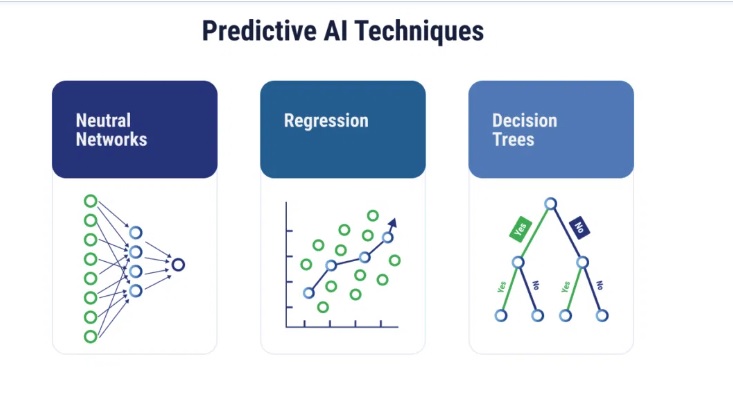
1. Neural Networks
Neural Networks Modeled after the human brain’s structure, neural networks comprise interconnected nodes adept at discerning patterns within data. Leveraging historical data, they excel at forecasting future events with precision, owing to their capacity to comprehend intricate datasets. This makes them invaluable across various predictive analytics domains.
2. Regression Analysis
Regression Analysis For scrutinizing the influence of one variable over another, regression analysis proves indispensable. AI streamlines this process, enabling the execution of both elementary and sophisticated models. By predicting a variable’s behavior based on the influence of others, it furnishes actionable insights crucial for informed decision-making.
3. Decision Trees
Decision Trees In scenarios where comprehending decision rationale is complex, decision trees offer clarity. By analyzing amassed data, they unveil decision logic, facilitating the formulation of algorithms for forecasting outcomes linked to specific variables. Decision trees stand as indispensable aids in bolstering comprehension and predictive prowess within analytics.
Harnessing The Power Of Data-Driven Insights
By harnessing the power of data-driven insights, AI-driven predictive analytics empowers enterprises to make informed decisions and optimise their operations.
As the technology continues to evolve, it is poised to revolutionise industries, presenting fresh opportunities for firms to embrace data-driven decision-making tools.
Use Cases For Predictive AI
The applications for predictive AI are vast and wide-ranging. Having some idea of what is coming in the future can be a huge advantage for a business, even if such predictions are not always accurate. Some of the possible predictive AI use cases include:
- Inventory management: Predictive AI can help identify times when consumer demand is likely to be higher and a brand or a store should have more items in stock.
- Supply chain management: Similarly, predictive AI can help determine when times of road congestion will occur or when more trucks are needed to meet spikes in user demand.
- Personalised user experiences: Predictive AI can help anticipate user behavior based on past activity.
- Healthcare: Given enough data, predictive AI could help forecast potential future health conditions based on a person’s medical history. (Health data, of course, is subject to strict regulatory frameworks like HIPAA.)
- Marketing campaigns: Just as predictive AI can anticipate user or customer behavior, it can help prognosticate what kinds of content or products that prospective customers may be interested in.
Distinguishing Predictive AI from Generative AI
Predictive AI and generative AI both leverage machine learning alongside vast datasets to generate outcomes. However, predictive AI focuses on extrapolating future trends, while generative AI is geared towards content creation.
For instance, a predictive AI iteration of Joey the fisherman might forecast impending storms to his peers, whereas a generative AI version of Joey might craft a novel envisioning diverse scenarios of weather and fishing expeditions.
Generative AI, in essence, shares similarities with predictive AI, employing statistical analysis to anticipate cohesive word and concept associations. Yet, their objectives, machine learning algorithms, and applications diverge significantly.
Predictive AI Conclusion & Summary
As we navigate the complexities of the digital age, it becomes increasingly clear that predictive AI is more than just an advanced technological tool – it’s a visionary compass guiding businesses towards sustainable growth amidst a rapidly changing world.
Embracing this powerful technology allows organisations to anticipate change proactively while safeguarding their assets against emerging threats.
Predictive AI empowers businesses to stay ahead of cyber threats with its proactive defense mechanisms. It transforms retail experiences by delivering personalized recommendations based on individual preferences while optimizing inventory management for seamless operations.
In healthcare, it revolutionizes patient care delivery by enabling early disease detection and personalized treatment plans. And in APAC, generative AI investments are fueling innovation across various industries.
The journey ahead may be challenging, but armed with predictive AI, businesses can navigate the future of technology and emerge as leaders in their respective fields.


